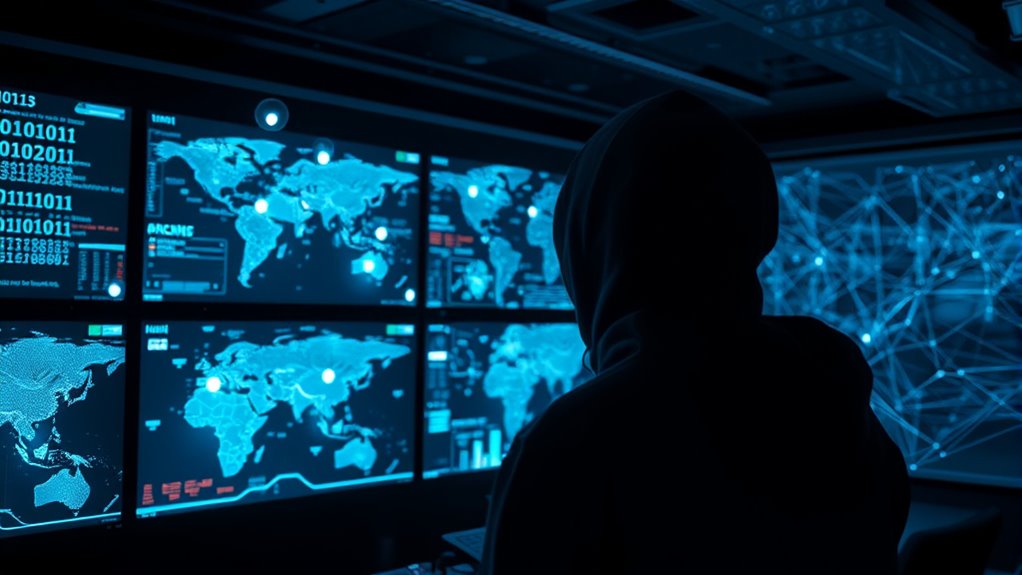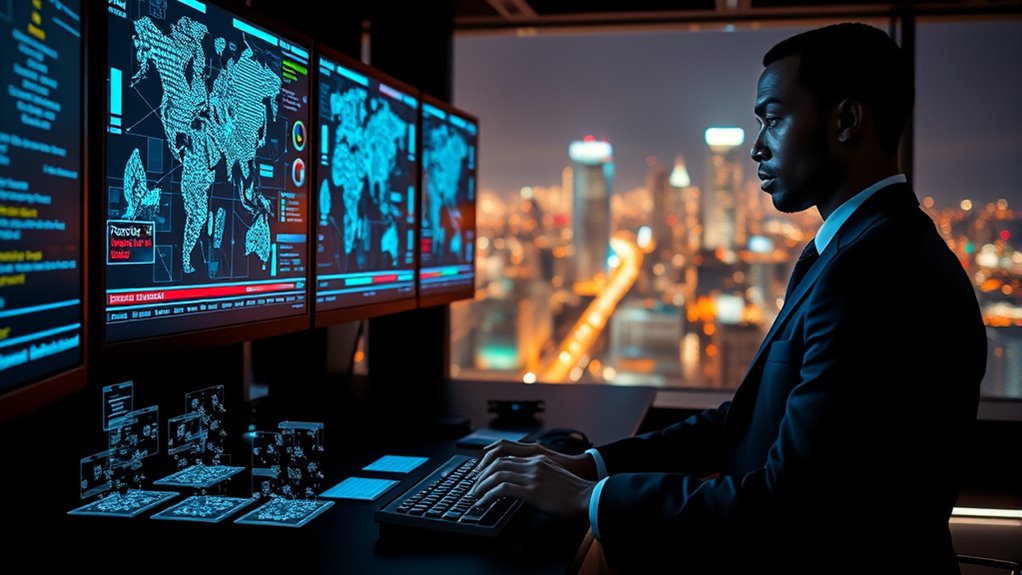To battle disinformation today, you need strong cybersecurity strategies that detect deepfakes and manipulated content early. Use available tools to scrutinize videos and images for signs of tampering, like inconsistent shadows or unnatural movements. Stay critical of what you see online, verify sources, and question sensational claims. Combining technology with media literacy helps prevent false narratives from spreading. Continue exploring these methods to better protect yourself and your community from digital deception.
Key Takeaways
- Implement advanced deepfake detection tools to identify manipulated images and videos before misinformation spreads.
- Promote media literacy practices, including source verification and skepticism of sensational content.
- Educate organizations and individuals on signs of manipulation, like inconsistent reflections or irregular blinking.
- Stay updated on evolving disinformation tactics and cybersecurity techniques to maintain effective defenses.
- Combine technological solutions with critical thinking to foster a resilient digital environment against false information.

In a world where misinformation spreads rapidly and facts are often questioned, cybersecurity has become more crucial than ever. As digital content becomes more sophisticated, so do the tools used to manipulate it. Deepfake detection has emerged as a critical component of your defense against deceptive media. These artificially generated videos and images can convincingly imitate real people, making it difficult to discern truth from fiction. When you’re exposed to a deepfake, it might look authentic, but with proper detection tools, you can identify subtle inconsistencies, such as unnatural facial movements or irregular blinking patterns. Implementing advanced deepfake detection techniques is essential for misinformation mitigation, helping you verify the authenticity of visual content before accepting it as fact. This process safeguards your perception of reality and prevents false narratives from spreading.
Deepfake detection safeguards reality by identifying subtle inconsistencies in AI-generated media to combat misinformation.
Cybersecurity professionals are actively developing algorithms that analyze video and audio for signs of manipulation. These systems scan for telltale signs—like mismatched shadows, inconsistent reflections, or irregular lip-sync—that are often overlooked by casual viewers. By integrating these detection methods into your daily digital interactions, you can markedly reduce the risk of falling victim to fabricated content. Such tools aren’t just for large organizations; anyone can leverage accessible software to scrutinize suspicious media. The goal is to create a layered defense, where detection of deepfakes becomes a routine part of content verification, thereby mitigating misinformation before it gains traction.
But detection alone isn’t enough. You need to build awareness of misinformation tactics and cultivate a healthy skepticism towards sensational content. Cybersecurity isn’t just about technical barriers; it’s about empowering yourself with knowledge. For instance, verifying sources, cross-referencing information, and recognizing emotionally charged language are practical steps in misinformation mitigation. When combined with technological solutions like deepfake detection, these habits strengthen your ability to navigate the post-truth landscape. The more vigilant you are, the less likely you’ll be manipulated by false narratives designed to sway opinions or spread chaos.
Ultimately, combating disinformation requires a proactive approach. As technology evolves, so must your defenses. Embracing advanced cybersecurity tools for deepfake detection and practicing critical media literacy are your best strategies for preserving truth in the digital age. Staying informed and cautious enables you to filter out distortion, ensuring you base your perceptions on verified facts. In this era where reality is often challenged, your commitment to cybersecurity and misinformation mitigation is essential to maintaining trust and clarity in an increasingly manipulated world.
Frequently Asked Questions
How Can Individuals Verify the Authenticity of Online Information Effectively?
To verify online information effectively, you should practice source verification by checking the credibility of the original source and cross-referencing with reputable outlets. Use critical thinking to question the content’s motives and look for biases. Don’t accept information at face value; instead, analyze the evidence and seek multiple perspectives. This proactive approach helps you discern fact from fiction and stay well-informed in a digital age rife with disinformation.
What Are the Latest Technological Developments in Detecting Disinformation?
You’re on the cutting edge when it comes to disinformation detection, as automated fact checking and AI-powered detection tools are rapidly evolving. These technologies analyze vast amounts of data in real time, flagging false information before it spreads. While they’re not foolproof, they’re a significant step forward—helping you stay one step ahead of misleading content and ensuring you rely on verified, trustworthy information rather than falling for smoke and mirrors.
How Do Governments Collaborate Internationally to Combat Digital Misinformation?
You can see governments collaborate internationally through alliances that focus on combating digital misinformation. They share data regularly, which helps identify and counter disinformation campaigns more effectively. These international alliances enable quick responses and coordinated efforts across borders. By pooling resources and expertise, governments can better protect their citizens from false information, foster trust, and maintain the integrity of digital spaces worldwide.
What Role Do Social Media Platforms Play in Mitigating Disinformation Spread?
Social media platforms play a pivotal role in mitigating disinformation spread by enhancing algorithmic transparency and managing user engagement. You can expect platforms to refine their algorithms to reduce the visibility of false content and promote reliable sources. They also monitor user interactions, flag or remove misleading posts, and provide users with tools to identify disinformation, helping you make informed decisions and limit the reach of false information.
How Can Businesses Protect Their Digital Assets From Disinformation Campaigns?
Imagine your digital assets as a locked vault, protected by layers of security. To defend against disinformation campaigns, you should prioritize media literacy and employ fact-checking tools to verify information before sharing. Regularly update your cybersecurity measures, train your team to recognize false content, and remain vigilant. These steps guarantee you’re not only securing your assets but also preventing the spread of falsehoods that can damage your reputation.
Conclusion
In this post-truth era, defending against disinformation is like steering a ship through stormy waters—you must stay alert and adaptable. By understanding cybersecurity’s role, you can better recognize and block false information before it spreads. Remember, you’re the lighthouse guiding others safely through confusion. Stay vigilant, keep learning, and don’t let disinformation sink your trust. Together, you can navigate these turbulent times and keep the digital world honest and secure.









